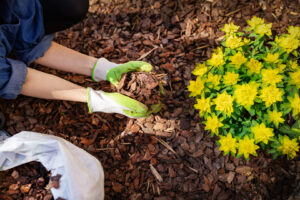
Here are a few reasons you should mulch your garden this fall.
Many of us are ready for a break this fall after a summer of gardening and spending time outdoors. However, before you retire your tools, it is essential to properly winterize your garden. A large part of winterizing your garden is adding new mulch to prepare for the growing season. Laying mulch in the fall can protect vulnerable plants from the harsh frost and winter temperatures. Here are a few more reasons you should mulch your garden this fall.
Mulch Reduces Weeds
A layer of mulch will discourage weeds from growing in the spring. The airborne seeds won’t reach the soil, while the weeds in the soil will not get enough sunlight. Mulching your garden is one of the best ways to prevent weeds from growing year-round. Properly mulching in the fall can save you a lot of time in the spring.
Mulch Prevents Soil Erosion
Heavy rains and strong winds can quickly erode the topsoil. You prevent erosion by placing a 2–4” layer of mulch over the soil, especially on sloping land or in an area with a lot of water flow. It is important to protect your topsoil before the snow falls and before the spring thaw.
Enriches the Soil
Growing plants can lose many nutrients in the soil during the summer. Mulching the soil in fall before the first snowfall provides your garden beds with dry matter that will break down over the winter, releasing nitrogen and essential minerals. It will also protect the earthworms from hard frost, and these worms are valuable resources in your garden that nourish the soil biome.
Protects Roots
Even hardy perennial plants can become too cold to thrive during harsh fall and winter temperatures. Mulch provides a layer of insulation that will help safeguard the roots from extreme temperatures and ensure that they grow next season. This is especially important for cold-weather crops like garlic and perennial fruit plants.
Tips for Laying Mulch in the Fall
Here are a few factors to consider when laying mulch this autumn:
- Mulch Type: Choose a quality mulch that looks great and lasts through the winter. Whatever mulch you choose, a depth of 2 inches is sufficient.
- Prepare Garden Beds: Remove all plant debris and pull any weeds that are still around.
- Start Before Frost: Lay mulch in the fall before the first frost kicks off colder temperatures.
- Tree Mulch: Don’t suffocate your tree with mulch. Taper the mulch depth from 2 inches to zero at the tree trunk instead of piling it up against the trunk. Mulch piled against the trunk keeps the moisture against the tree, which can soften the bark and weaken it to pests.
Questions? Lehnhoff’s Supply is Here to Help
If you still have more questions about fall mulching, the trained professionals at Lehnhoff’s Supply are here to help you.
Find us at 2708 Belair Road, Fallston, MD 21047 and give us a call at 410-510-7646. For tips, tricks, and to see what we have been up to, be sure to follow us on Facebook, X – Twitter, and Pinterest!
We serve but aren’t limited to, the following parts of Maryland: Harford County – Fallston, Forest Hill, Joppa, Edgewood, Bel Air, Churchville, Havre de Grace, Jarrettsville, Street, Aberdeen, Abingdon, and Joppatowne. In Baltimore County: Kingsville, Perry Hall, Overlea, Fullerton, Nottingham, Parkville, Towson, Carney, Loch Raven, Lutherville, Timonium, Hunt Valley, Cockeysville, Sparks, Glyndon, Pikesville, Reisterstown, Ruxton, Parkton, Glen Arm, Baldwin, Monkton, Long Green, White Marsh, Rosedale, Phoenix, and Fork.
